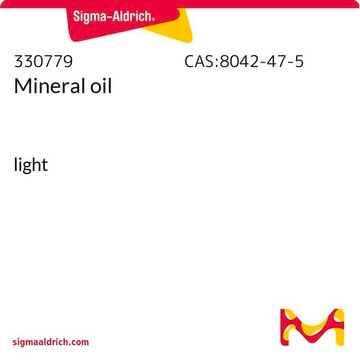W358118
3-Octanol
≥97%, FCC, FG
Synonyme(s) :
Ethyl pentyl carbinol
About This Item
Produits recommandés
Source biologique
synthetic
Niveau de qualité
Qualité
FG
Halal
Kosher
Agence
meets purity specifications of JECFA
Conformité réglementaire
EU Regulation 1334/2008 & 178/2002
FCC
FDA 21 CFR 172.515
Densité de vapeur
~4.5 (vs air)
Pression de vapeur
~1 mmHg ( 20 °C)
Pureté
≥97%
Indice de réfraction
n20/D 1.426 (lit.)
Point d'ébullition
174-176 °C (lit.)
Densité
0.818 g/mL at 25 °C (lit.)
Application(s)
flavors and fragrances
Documentation
see Safety & Documentation for available documents
Allergène alimentaire
no known allergens
Propriétés organoleptiques
creamy; mushroom; musty; earthy; minty; waxy
Chaîne SMILES
CCCCCC(O)CC
InChI
1S/C8H18O/c1-3-5-6-7-8(9)4-2/h8-9H,3-7H2,1-2H3
Clé InChI
NMRPBPVERJPACX-UHFFFAOYSA-N
Vous recherchez des produits similaires ? Visite Guide de comparaison des produits
Catégories apparentées
Application
- RIFM fragrance ingredient safety assessment, 3-octanol, CAS Registry Number 589-98-0: This safety assessment review offers a thorough examination of 3-Octanol′s application in the fragrance industry, discussing its solvent properties, safety, and handling in laboratory settings, thus serving as a critical reference for researchers focused on industrial applications and safety of fragrance ingredients (Api et al., 2021).
Actions biochimiques/physiologiques
Autres remarques
Mention d'avertissement
Warning
Mentions de danger
Conseils de prudence
Classification des risques
Eye Irrit. 2
Code de la classe de stockage
10 - Combustible liquids
Classe de danger pour l'eau (WGK)
WGK 2
Point d'éclair (°F)
154.4 °F
Point d'éclair (°C)
68 °C
Équipement de protection individuelle
Eyeshields, Gloves, type ABEK (EN14387) respirator filter
Certificats d'analyse (COA)
Recherchez un Certificats d'analyse (COA) en saisissant le numéro de lot du produit. Les numéros de lot figurent sur l'étiquette du produit après les mots "Lot" ou "Batch".
Déjà en possession de ce produit ?
Retrouvez la documentation relative aux produits que vous avez récemment achetés dans la Bibliothèque de documents.
Les clients ont également consulté
Notre équipe de scientifiques dispose d'une expérience dans tous les secteurs de la recherche, notamment en sciences de la vie, science des matériaux, synthèse chimique, chromatographie, analyse et dans de nombreux autres domaines..
Contacter notre Service technique











